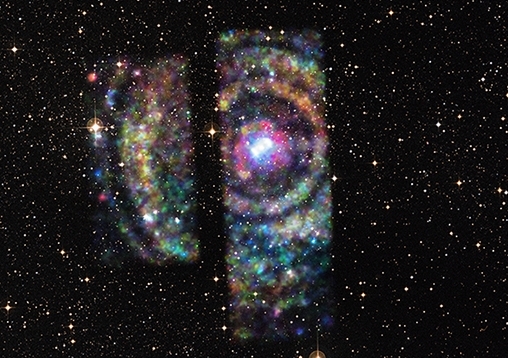Lord of the Rings – distance to bizarre galactic X-ray source determined
Astronomers have measured the distance to one of the Milky Way’s most bizarre objects for the first time, using the Australian Mopra radio telescope near Coonabarabran.
Astronomers have measured the distance to one of the Milky Way’s most bizarre objects for the first time, using the Australian Mopra radio telescope near Coonabarabran.

Deborah Smith
UNSW Media
9385 7307 or 0478 492 060
deborah.smith@unsw.edu.au
Astronomers have measured the distance to one of the Milky Way’s most bizarre objects for the first time, using the Australian Mopra radio telescope near Coonabarabran.
Circinus X-1 is a binary star system that exploded a mere 2,500 years ago. It consists of a dense, collapsed neutron star, still in the orbital embrace of its companion star, and flashes X-rays as material from the companion star spirals into the neutron star and reaches high temperatures.
“We have been able to work out that this strange object is 31,000 light years away, using Mopra’s ability to detect clouds of dust in interstellar space,” says study co-author, UNSW astrophysicist, Professor Michael Burton.
UNSW’s Dr Catherine Braiding, also a study co-author, adds: "Circinus X-1 acts in some ways like a neutron star and in some like a black hole. It's extremely unusual to find an object that has such a blend of these properties."
The research will be published in the Astrophysical Journal and is available now online.
In late 2013, Circinus-X gave off a massive burst of X-rays in an event that lasted about two months. The flare was monitored by a detector on board the International Space Station.
Researchers led by Professor Sebastian Heinz at the University of Wisconsin-Madison then quickly mounted a series of follow-up observations using two space-based telescopes – the Chandra X-ray Observatory and the XMM-Newton Observatory.
They discovered four bright rings of X-rays around the neutron star at the heart of Circinus X-1.
“These rings indicated there were dense clouds of gas between us and Circinus X-1, and that some of the X-rays from the massive outburst had been deflected off these particles of dust on their way to Earth,” says Professor Burton.
“Using Mopra, we were able to find these clouds of gas, and locate their distance from us.
"We like to call this system the 'Lord of the Rings', but this one has nothing to do with Sauron. The beautiful match between the Chandra X-ray rings and the Mopra radio images of the different clouds is really a first in astronomy."
The team then worked out the distance to Circinus X-1, based on the differences in time it took X-rays to reach Earth directly and to reach Earth on a longer trajectory after being deflected by the gas clouds.
“Distance measurements in astronomy are difficult, especially to sources like Circinus X-1, which are hidden in the plane of the galaxy behind a thick layer of dust, which basically makes it impossible to observe them with optical telescopes,” says Professor Heinz.
“In this case we used the dust that otherwise gets in the way to pioneer a new method for estimating distance to X-ray sources.”
The Mopra Telescope is a 22-metre single-dish radio telescope near Coonabarabran, 450 kilometres from Sydney. It has been mapping the centre of our galaxy, the Milky Way, for more than four years but is due to close later this year due to Federal Government funding cuts.